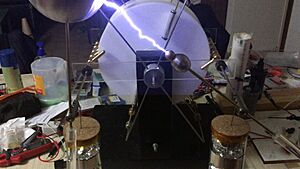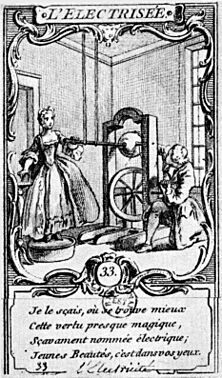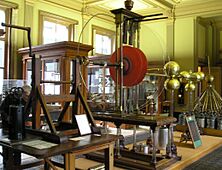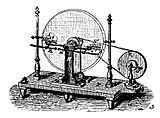Electrostatic generator facts for kids
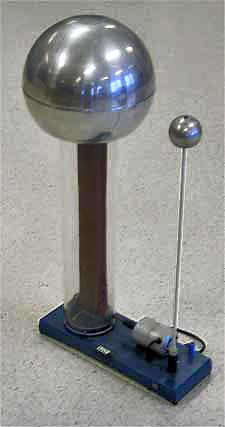
An electrostatic generator is a special kind of electric generator. It makes static electricity, which is electricity at a very high voltage but with a very small electric current. People have known about static electricity for thousands of years, but for a long time, it was just a mysterious thing. They didn't have a good way to explain how it worked.
By the end of the 1600s, scientists learned how to make electricity by rubbing things together. But the real work on electrostatic machines didn't start until the 1700s. These machines became super important tools for studying the new science of electricity.
Electrostatic generators work by changing mechanical work (like turning a crank) into electric energy. Manual generators create electrical charges that are opposite on two different parts. They use moving parts like plates, drums, or belts to carry electric charge to a high-voltage part called an electrode.
Contents
What are Electrostatic Machines Used For?
Electrostatic machines are often used in science classrooms. They help teachers safely show how electrical forces work and how high voltage behaves. The very high voltages they create have also been used for many practical things. These include powering X-ray tubes, particle accelerators (machines that speed up tiny particles), and for medical uses.
Some famous electrostatic generators, like the Van de Graaff generator and the Pelletron, are still used in physics research today.
Electrostatic generators can be grouped by how they make the charge:
- Friction machines use the triboelectric effect. This is when electricity is made by touching or rubbing things together.
- Influence machines use electrostatic induction. This is when a charged object makes a charge appear on another object without touching it.
Friction Machines
Friction machines were the first type of electrostatic generators. They got their name because they used friction to create electricity.
History of Friction Machines
Around 1663, Otto von Guericke made a very early friction machine. It used a globe made of sulfur that could be spun and rubbed by hand. Later, Isaac Newton suggested using a glass globe instead. Around 1706, Francis Hauksbee improved this design. His machine had a glass sphere that could be spun quickly against a wool cloth.
In the 1730s, Professor Georg Matthias Bose added a "collecting conductor." This was an insulated tube that collected the electricity. He was the first to use a "prime conductor" in these machines.
In 1746, William Watson built a machine with a large wheel that turned several glass globes. The invention of the Leyden Jar helped a lot with experiments using these machines. A Leyden Jar is an early type of capacitor. It can store a lot of electrical charge.
Over the years, many scientists improved these machines. Andrew Gordon used a glass cylinder instead of a globe. John Canton made them more efficient by adding a special metal mix to the rubbing surface. In 1768, Jesse Ramsden built a very popular plate-style electrical generator.
In 1783, the Dutch scientist Martin van Marum designed a very large and powerful electrostatic machine. It had glass disks that were 1.65 meters (about 5.4 feet) wide! This machine is still on display today at the Teylers Museum in Haarlem.
How Friction Machines Work
When you rub two different surfaces together and then pull them apart, you can create a charge imbalance. This is called the triboelectric effect, and it leads to static electricity. For example, rubbing a balloon on your hair makes both charged.
Rubbing two objects that don't conduct electricity (like rubber or plastic) can create a lot of static electricity. This isn't just about friction. If you just place two non-conductive surfaces on top of each other, they can also become charged. Rubbing them just increases how much they touch.
Materials that don't conduct electricity, called insulators, are good at both making and holding a surface charge. Examples include rubber, plastic, glass, and pith.
Influence Machines
Over time, friction machines were replaced by influence machines. These machines work using electrostatic induction. They turn mechanical work into electrical energy. They use a small starting charge, which they keep making bigger.
History of Influence Machines
The idea for influence machines came from Volta's electrophorus. This device uses electrostatic induction to create imbalances of electric charge.
Then, in 1787, Abraham Bennet (who invented the gold leaf electroscope) described a "doubler of electricity." This device could make a small charge much bigger by repeating manual steps with three insulated plates. In 1788, William Nicholson created the first rotating influence machine.
Many others improved these rotating doublers. In 1831, Giuseppe Belli made a simple, balanced doubler. This machine was later reinvented by others, including Lord Kelvin in 1868.
Holtz Machine
Between 1864 and 1880, W. T. B. Holtz built many influence machines. These were considered the most advanced of their time. A Holtz machine often had a glass disk that spun very fast. This disk interacted with other induction plates.
Wimshurst Machine
In 1878, James Wimshurst began studying electrostatic generators. He improved the Holtz machine, making a powerful version with multiple disks. The classic Wimshurst machine became the most popular type of influence machine around 1883.
The Wimshurst machine is quite simple. Like all influence machines, it uses electrostatic induction. This means it uses even the tiniest existing charge to create and collect more charges. It keeps doing this as long as the machine is working.
A Wimshurst machine has:
- Two insulated disks that spin in opposite directions. These disks have small metal plates on them.
- Two double-ended brushes that help stabilize the charge and where induction happens.
- Two pairs of collecting combs that gather the electrical charge.
- Two Leyden Jars, which are like capacitors that store the charge.
- A pair of electrodes to transfer the charges once enough have been collected.
Because it's simple to build and use, the Wimshurst machine is a common choice for science experiments and demonstrations at home or school.
Pidgeon Machine
In 1898, W. R. Pidgeon developed the Pidgeon machine. This machine had a special design that made the electrostatic induction effect stronger. It also had better insulation to stop charge from leaking away. Pidgeon machines combine features of Wimshurst and Voss machines. They are known for exciting themselves (starting to produce charge) more easily.
Around the early 1900s, people also developed machines with multiple disks or "triplex" machines (with three disks). In 1900, F. Tudsbury found that putting a generator in a metal box with compressed air (or carbon dioxide) made it work much better. This is because compressed gases are better insulators.
Van de Graaff Generator

The Van de Graaff generator was invented by American physicist Robert J. Van de Graaff in 1929. He first showed a model in October 1929. In this machine, an insulating belt carries electric charge up into a hollow metal sphere. Inside the sphere, a "comb" of metal points transfers the charge to the sphere.
The clever part of this design is that there's no electric field inside the hollow sphere. This means the belt can keep adding charge to the sphere, no matter how high the voltage on the sphere gets! The only limit to the voltage is when the air next to the sphere starts to break down (ionize), which happens at very high electric fields. To avoid this, the sphere is made very smooth and round. The bigger the sphere, the higher the voltage it can reach.
The first machine used a silk ribbon as the charge-carrying belt. By 1931, a version that could produce 1,000,000 volts was described!
Van de Graaff generators were very successful as particle accelerators. They produced the highest energies until the late 1930s when the cyclotron took over. To get even higher voltages (up to 25 million volts), these generators are put inside a tank filled with pressurized insulating gas. These powerful Van de Graaff accelerators are still used in medicine and research today.
Small Van de Graaff generators are often seen in science museums and schools. They are great for showing how static electricity works. A popular demonstration is when a person touches the high-voltage sphere while standing on an insulated platform. The high voltage charges the person's hair, making it stand straight out from their head!
Other Types of Generators
Not all electrostatic generators use rubbing (triboelectric effect) or induction. Some make electric charges directly from electric currents. Examples include ionizers and ESD guns.
Applications
Electrostatic generators have some interesting uses:
EWICON
The EWICON is an electrostatic wind generator developed at Delft University of Technology. It has no moving parts except for the wind itself. It works by the wind carrying away charged particles from its collector.
Air Ioniser
An Air ioniser uses electrostatic principles to charge air molecules.
Interesting Devices
Some generators have been used in less traditional ways. For example, in the 1960s, a machine called "Testatika" was built. It was based on the 1898 Pidgeon electrostatic machine and claimed to produce "free energy" from the environment.
See also
- Electrostatic motor
- Electrometer
- Static electricity


